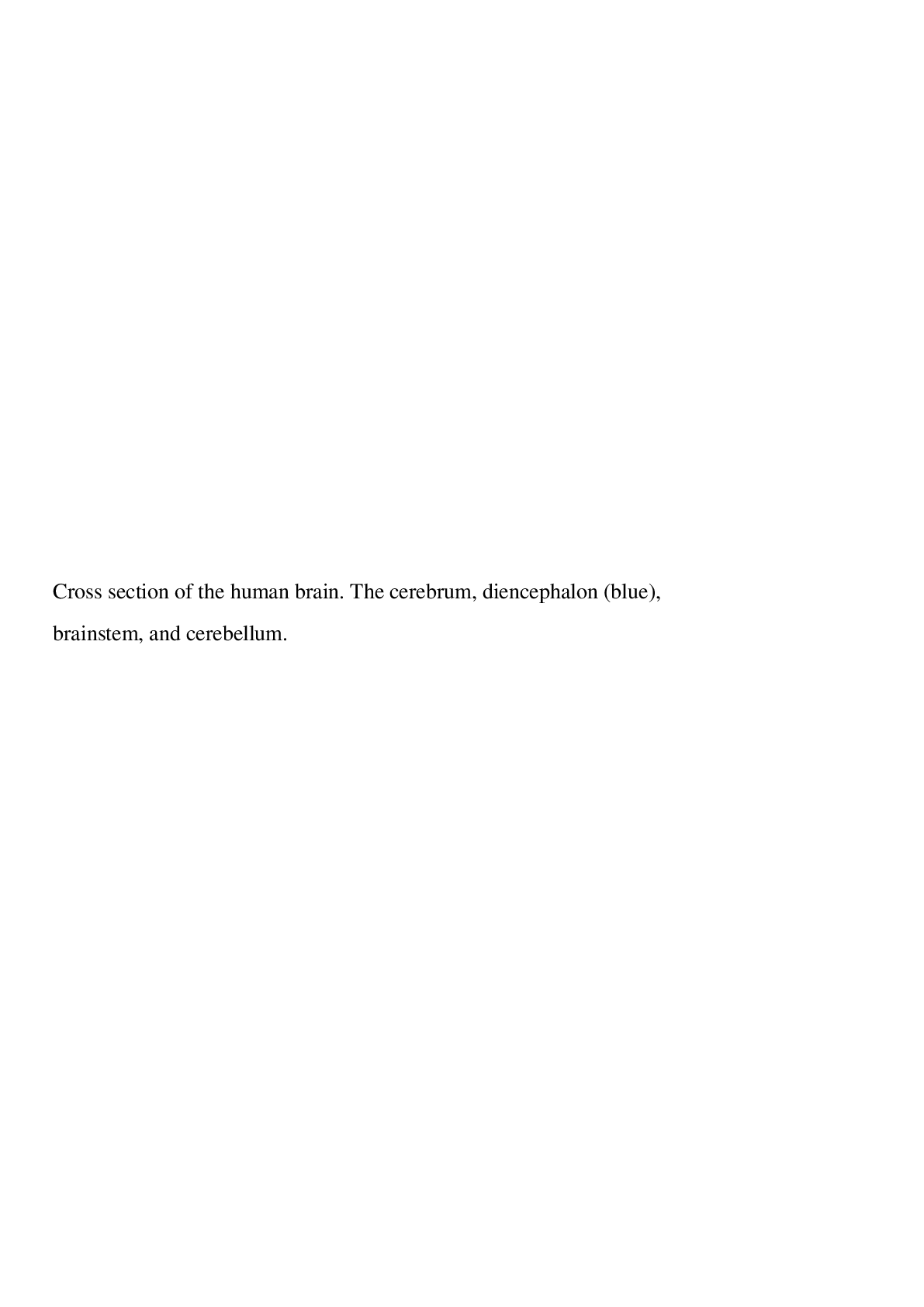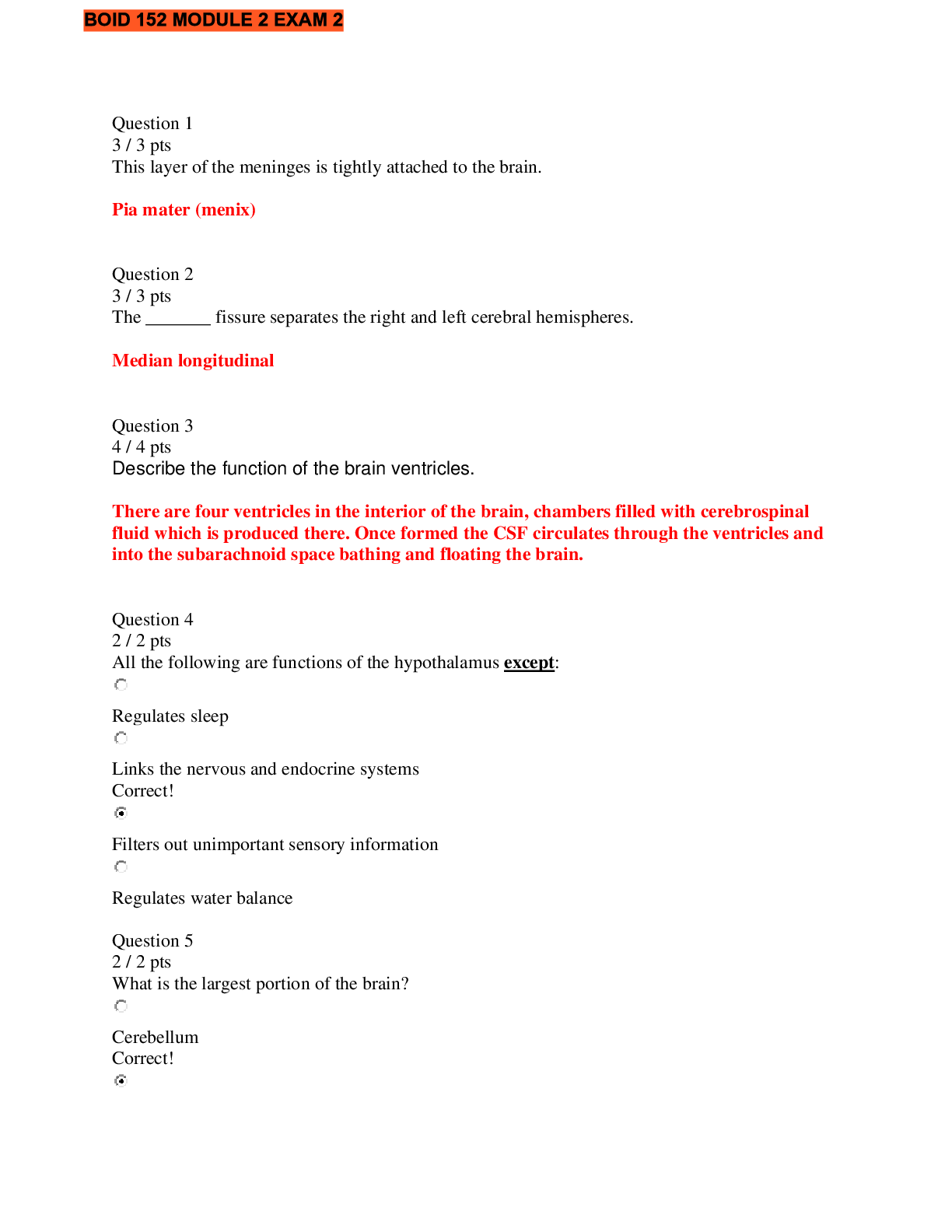Medical Studies > QUESTIONS & ANSWERS > Certified Postanesthesia Nurse CPAN Exams Forms 1-4, Answered_2022. Questions with accurate solution (All)
Certified Postanesthesia Nurse CPAN Exams Forms 1-4, Answered_2022. Questions with accurate solutions.
Document Content and Description Below
A 60-year-old female is admitted to the PACU following a diagnostic dilation and curettage with general anesthesia. Chart review reveals normal preoperative EKG-hemoglobin-hematocrit- and electrolyte ... values. Past medical history is remarkable for rheumatic fever during childhood. Thirty minutes later the patient develops the following EKG pattern --- A-fib--- The perianesthesia nurse interprets the rhythm strip as indicating A. Occasional premature atrial contractions B. First-degree heart block C. Atrial flutter D. Atrial fibrillation - Ans-A. Occasional premature atrial contractions B. First-degree heart block C. Atrial flutter *D. Atrial fibrillation* A 60-year-old female is admitted to the PACU following a diagnostic dilation and curettage with general anesthesia. Chart review reveals normal preoperative EKG-hemoglobin-hematocrit- and electrolyte values. Past medical history is remarkable for rheumatic fever during childhood. Thirty minutes later the patient develops the following EKG pattern --- A-fib--- If the defibrillator is not set on the synchronized mode during a cardioversion- which life threatening arrhythmia could occur? A. Ventricular fibrillations B. Wenckebach's phenomenon C. Premature ventricular contractions D. Ventricular tachycardia -Ans-*Ventricular fibrillations* Wenckebach's phenomenon Premature ventricular contractions Ventricular tachycardia A 60-year-old female is admitted to the PACU following a diagnostic dilation and curettage with general anesthesia. Chart review reveals normal preoperative EKG-hemoglobin-hematocrit- and electrolyte values. Past medical history is remarkable for rheumatic fever during childhood. Thirty minutes later the patient develops the following EKG pattern --- A-fib--- The patient is transferred to a surgical nursing unit following successful cardioversion because the ICU and monitored units are full. The PACU nurse should emphasize assessment for A. Atrioventricular dissociation B. Thermal incident C. Sinus bradycardia D. Emboli - Ans-A. Atrioventricular dissociation B. Thermal incident C. Sinus bradycardia D. * Emboli* The perianesthesia nurse has given the patient instructions regarding taking medications on the day of surgery. Which statement indicates that the patient understands the pre-op teaching A. "I will only have small amounts of water with the medications I take on the morning of surgery" B. "Since I have atrial fibrillation, I need to take my warfarin on the morning of surgery" C. "I will take my vitamins and herbal supplements on the morning of surgery" D. "Since I am diabetic, I need to take my insulin and eat breakfast every day" - Ans-A. *"I will only have small amounts of water with the medications I take on the morning of surgery"* B. "Since I have atrial fibrillation, I need to take my warfarin on the morning of surgery" C. "I will take my vitamins and herbal supplements on the morning of surgery" D. "Since I am diabetic, I need to take my insulin and eat breakfast every day" A patient in Phase II is complaining of nausea and refusing any medication. Which essential oil may be inhaled to treat post-operative nausea and vomiting? A. Rose B. Sandalwood C. Lemongrass D. Peppermint - Ans-A. Rose B. Sandalwood C. Lemongrass D. *Peppermint* Which one of the following positions would be indicated for a left lower lobectomy? A. Flat bed rest B. Turned to operative side only C. Turned to nonoperative side only D. Semi-Fowler's position with turning to either side - Ans-A. Flat bed rest B. Turned to operative side only C. Turned to nonoperative side only D. *Semi-Fowler's position with turning to either side* A patient with an implantable cardioverter defibrillator (ICD) arrives in the PACU with a magnet over the generator. The perianesthesia nurse should: A. Remove the magnet so the ICD is activated B. Remove the magnet so the ICD is deactivated C. Educate the patient on the care of the magnet D. Adjust the placement of the magnet - Ans-A. *Remove the magnet so the ICD is activated* B. Remove the magnet so the ICD is deactivated C. Educate the patient on the care of the magnet D. Adjust the placement of the magnet A patient with a subarachnoid hemorrhage is lethargic but arousable. The patient is taken to surgery for an aneurysm clipping. ABG shows pH= 7.50 pCO2= 45 mm HG and HCO3-= 30 mEq/L. The perianesthesia nurse interprets this as: A. Respiratory alkalosis B. Respiratory acidosis C. Metabolic acidosis D. Metabolic alkalosis - Ans-A. Respiratory alkalosis B. Respiratory acidosis C. Metabolic acidosis D. *Metabolic alkalosis* While caring for a patient after lumbar posterior nerve root rhizotomy the perianesthesia nurse notes the patient has no movement or sensation to the lower extremities. The priority nursing action is to notify the: A. Anesthesiologist of muscle paralysis B. Operating room of the complications C. Surgeon of the absence of sensation D. Surgeon of lack of motor ability - Ans-A. Anesthesiologist of muscle paralysis B. Operating room of the complications C. Surgeon of the absence of sensation D. *Surgeon of lack of motor ability* While assisting an anesthesiologist performing a block for reflex sympathetic dystrophy the perianesthesia nurse observes that the affected arm becomes warm to the touch and flushed. The patient reports a sensation of heaviness in the arm. This indicates which of the following? A. Ineffective regional block B. Severe allergic reaction C. Successful therapeutic block D. Extravasation of the medication - Ans-A. Ineffective regional block B. Severe allergic reaction C. *Successful therapeutic block* D. Extravasation of the medication The perianesthesia nurse receives a patient post total parathyroidectomy. The patient is awake and oriented with a patent airway but complains of tingling around the mouth- slight hoarseness- and is mildly apprehensive. The perianesthesia nurse suspects: A. Vocal cord irritation B. Hypocalcemia C. Hypercalcemia D. Compromised airway -Ans-A. Vocal cord irritation B. *Hypocalcemia* C. Hypercalcemia D. Compromised airway The perianesthesia nurse receives a patient post total parathyroidectomy. The patient is awake and oriented with a patent airway but complains of tingling around the mouth- slight hoarseness- and is mildly apprehensive. The perianesthesia nurse's next action is to: A. Instruct the patient to remain silent to rest the vocal cords B. Have patient say "e" to check for nerve damage C. Call surgeon and anticipate an order for a calcium level D. Administer pain medication and look for signs of hemorrhage - Ans-A. Instruct the patient to remain silent to rest the vocal cords B. Have patient say "e" to check for nerve damage C. *Call surgeon and anticipate an order for a calcium level* D. Administer pain medication and look for signs of hemorrhage A 3-year-old patient arrives in the PACU following general anesthesia. The patient has a croupy cough- inspiratory stridor- and intercostal retractions are noted. Humidified oxygen is being administered at 8L/min via blow by. Initially the perianesthesia nurse anticipates: A. Administration of nebulized racemic epinephrine B. Assisting the patient's breathing with BMV C. Maintaining the patient's head in the sniff position D. Suctioning the patient's oropharynx - Ans-A. *Administration of nebulized racemic epinephrine* B. Assisting the patient's breathing with BMV C. Maintaining the patient's head in the sniff position D. Suctioning the patient's oropharynx A postoperative pediatric tympanoplasty patient is asked to wrinkle the forehead- pucker lips- smile- and squeeze eyelids together. The PACU nurse is assessing the function of cranial nerve: A. V B. VII C. IX D. XII - Ans-A. V B. *VII* C. IX D. XII Evaluation calls made to an ambulatory patient during the 24-hour period after discharge can provide effective post-operative follow-up. This nursing action is most important to : A. Transfer aftercare to a public health nurse B. Give the patient a chance to ask questions and identify problems in the care given C. Advertise the institution's ambulatory surgery program D. Facilitate readmission in the event of complications - Ans-A. Transfer aftercare to a public health nurse B. *Give the patient a chance to ask questions and identify problems in the care given* C. Advertise the institution's ambulatory surgery program D. Facilitate readmission in the event of complications Following stabilization of femur and pelvic fractures a patient becomes anxious and oxygen saturations decrease to 86%. The patient continues to become confused and agitated. Upon further assessment the perianesthesia nurse notes petechiae on the patient's trunk. The perianesthesia nurse suspects: A. Fat embolism B. Tension pneumothorax C. Compartment syndrome D. Neurogenic bladder - Ans-A. *Fat embolism* B. Tension pneumothorax C. Compartment syndrome D. Neurogenic bladder In a young healthy post-operative patient hypoventilation may be reversed by: A. Restriction of fluids B. Administration of oxygen C. Stimulation of the patient D. Administration of pain medication - Ans-A. Restriction of fluids B. Administration of oxygen C. *Stimulation of the patient* D. Administration of pain medication A patient with type I diabetes is admitted the day of surgery with a glucose of 400 mg/dL. The nurse is aware that the patient may be at risk for: A. Hyperglycemic hyperosmolar syndrome B. Anuria C. Diabetic ketoacidosis D. Diabetes insipidus - Ans-A. Hyperglycemic hyperosmolar syndrome B. Anuria C. *Diabetic ketoacidosis* D. Diabetes insipidus During the interview of a 55-year-old patient before elective surgery the patient reports using no routine prescription medications- just some natural herbs. The perianesthesia nurse is aware that- according to the ASA- teaching should include which of the following? A. Continue all herbal supplements that are taken in the evening B. Discontinue all herbal supplements 2 weeks prior to surgery C. Herbal supplements have no contraindications for surgery D. Continue all herbal supplements until 2 days prior to surgery - Ans-A. Continue all herbal supplements that are taken in the evening B. *Discontinue all herbal supplements 2 weeks prior to surgery* C. Herbal supplements have no contraindications for surgery D. Continue all herbal supplements until 2 days prior to surgery The occurrence of post-dural puncture headache is most frequently attributed to: A. A history of migraine headaches B. Poor positioning C. A slow loss of cerebrospinal fluid at puncture site D. Caffeine deprivation - Ans-A. A history of migraine headaches B. Poor positioning C. *A slow loss of cerebrospinal fluid at puncture site* D. Caffeine deprivation Asking the patient to position the tongue in midline following a carotid endarterectomy helps the perianesthesia nurse to assess the: A. Acoustic nerve B. Hypoglossal nerve C. Glossopharyngeal nerve D. Facial nerve - Ans-A. Acoustic nerve [Show More]
Last updated: 1 year ago
Preview 1 out of 62 pages
Instant download
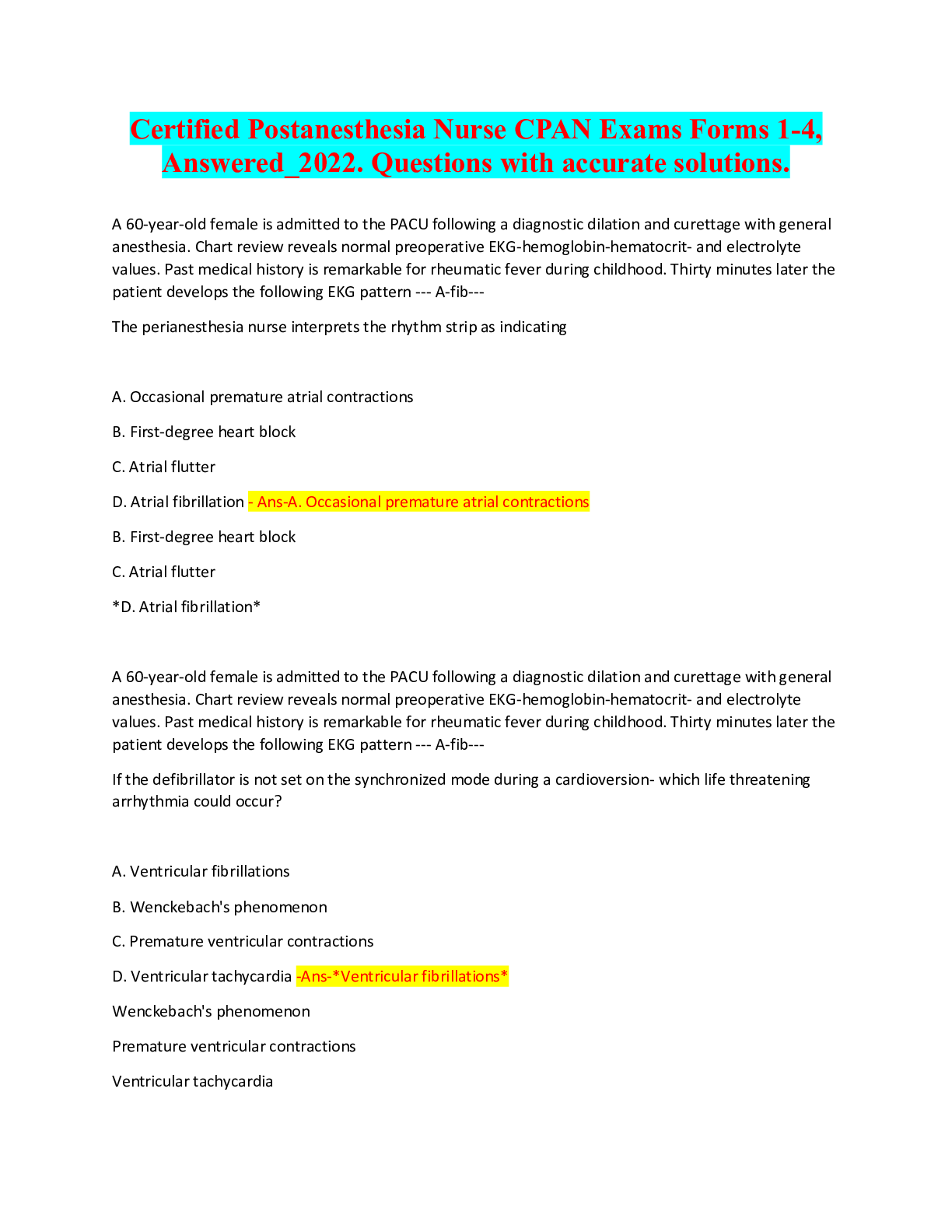
Buy this document to get the full access instantly
Instant Download Access after purchase
Add to cartInstant download
Reviews( 0 )
Document information
Connected school, study & course
About the document
Uploaded On
May 26, 2022
Number of pages
62
Written in
Additional information
This document has been written for:
Uploaded
May 26, 2022
Downloads
0
Views
86












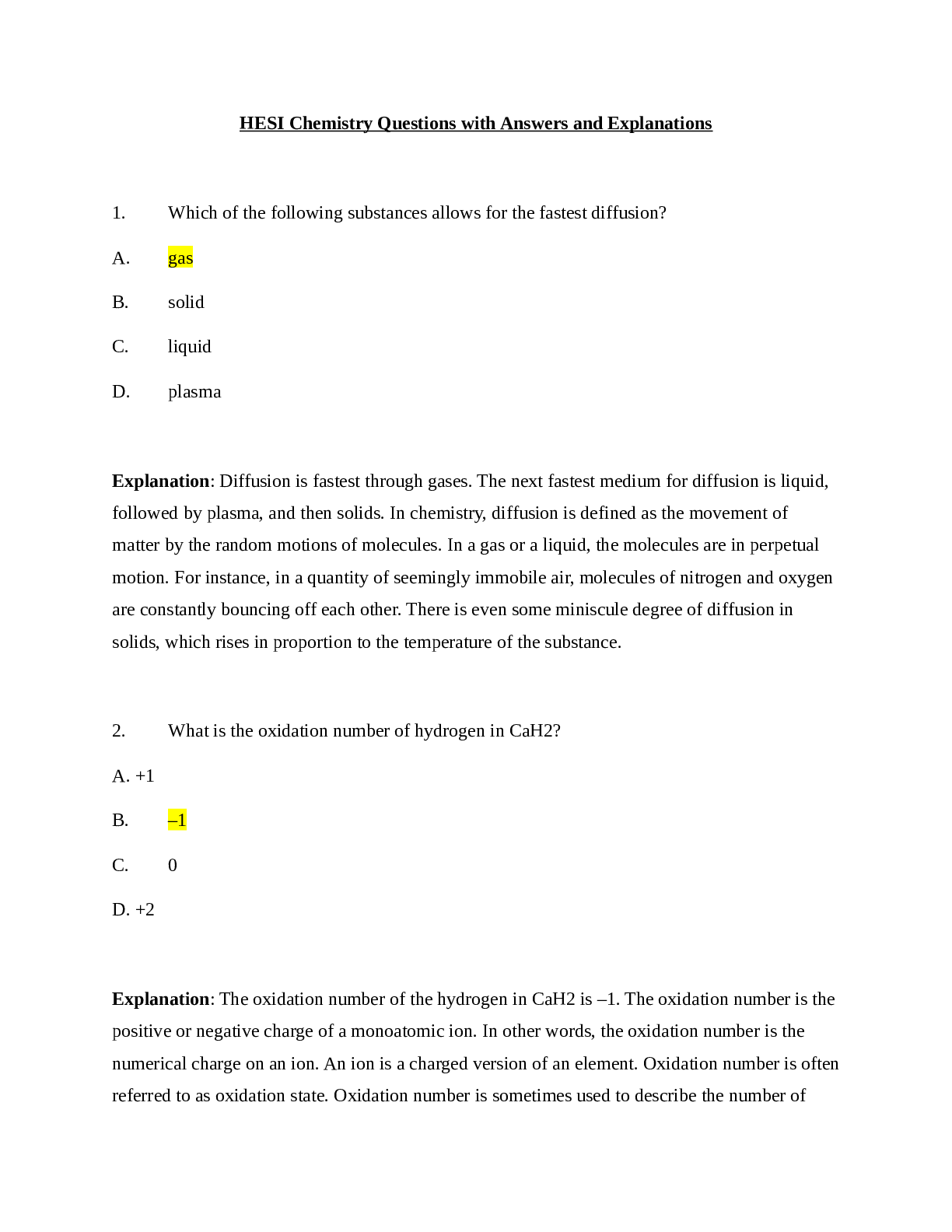

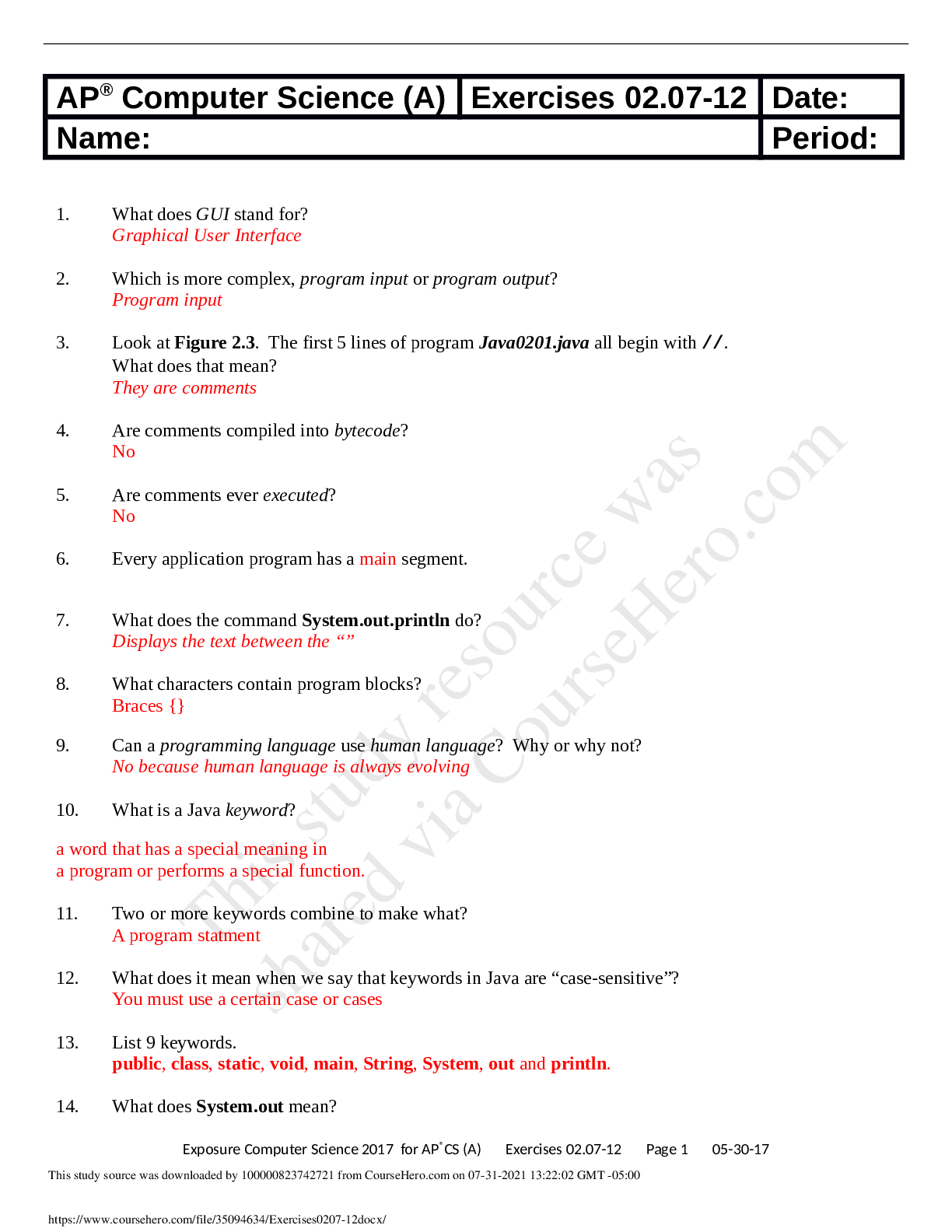
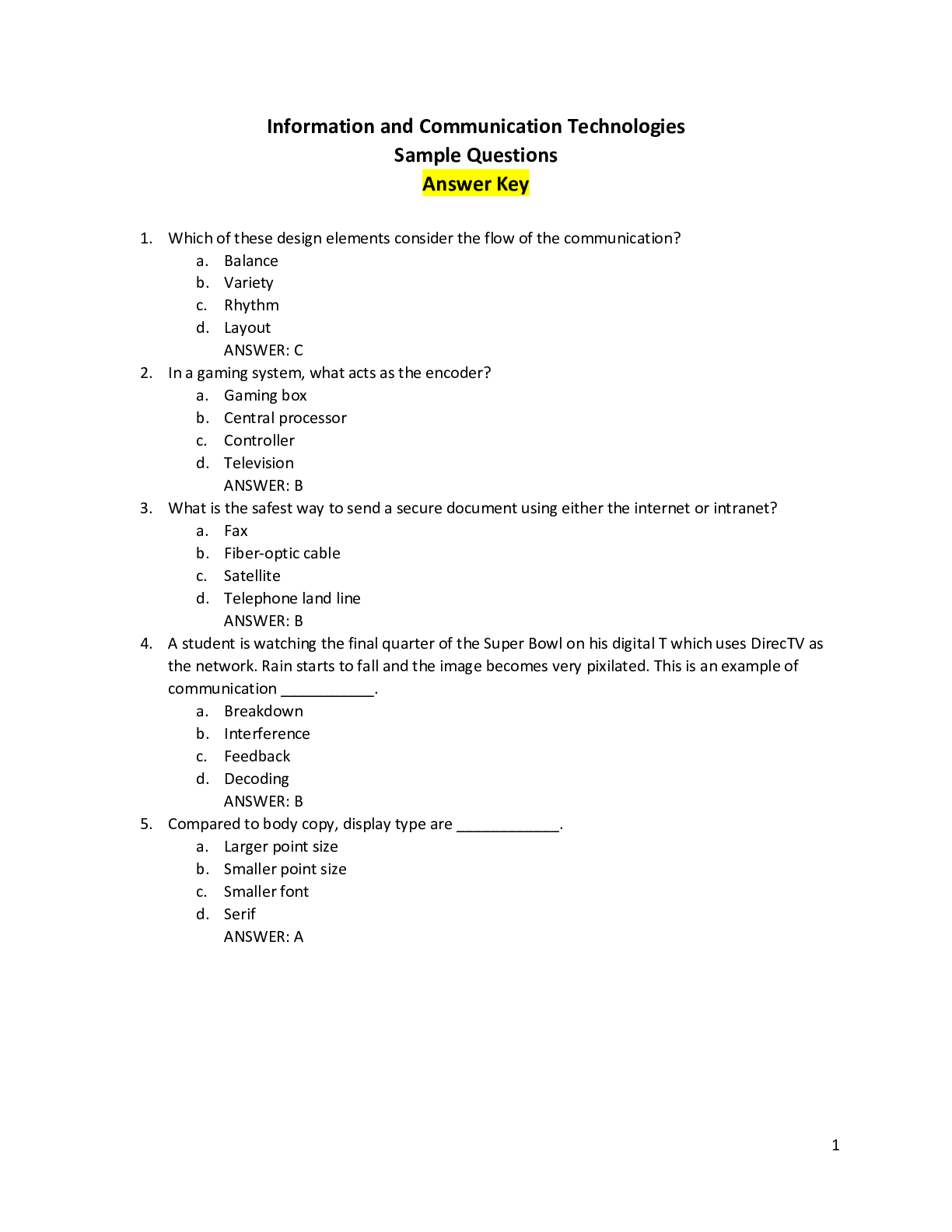
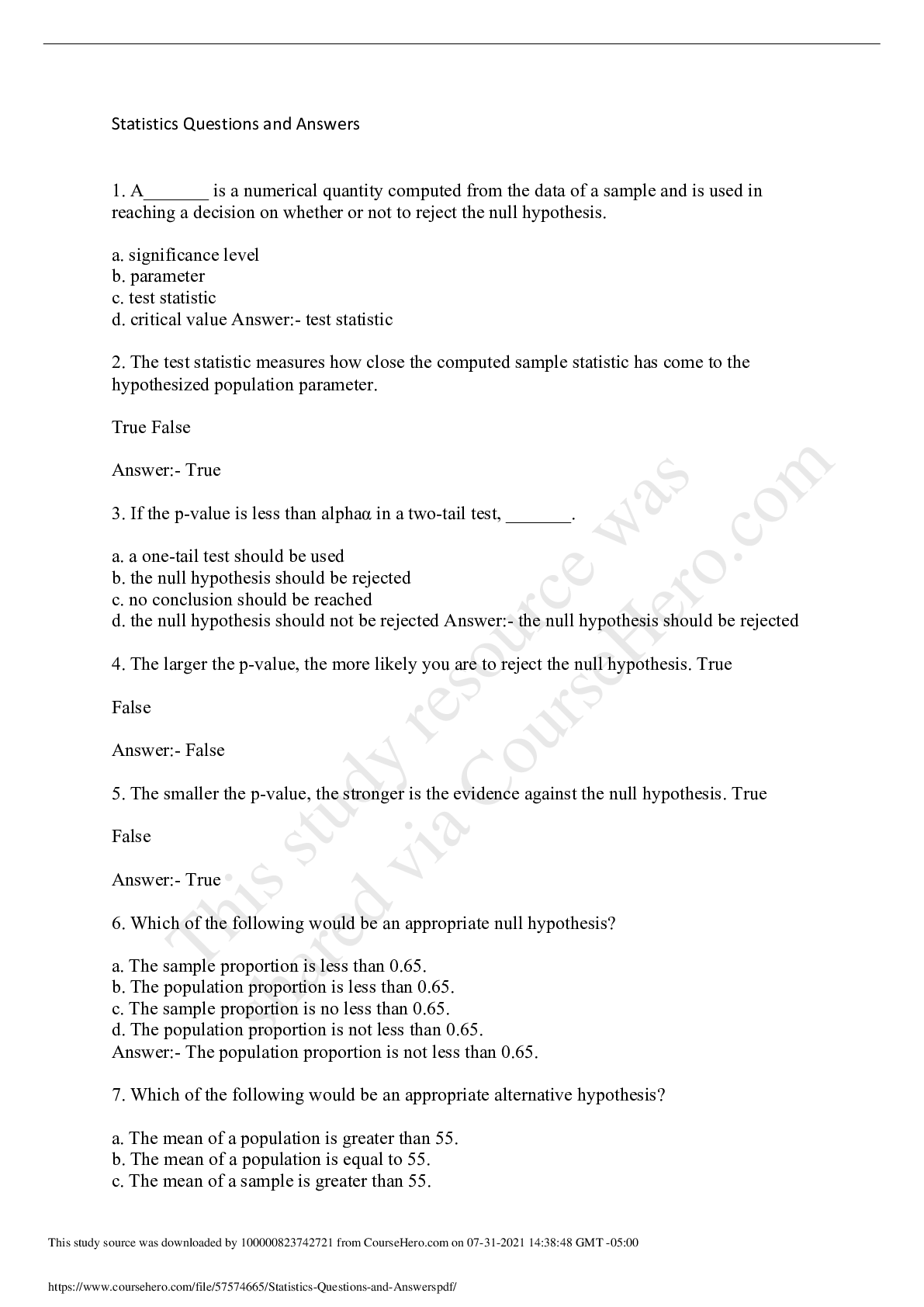
.png)

.png)
